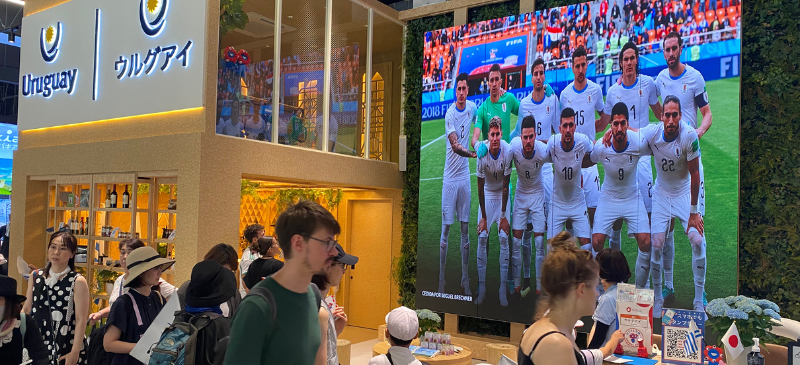- Home
- About us
- News
- Events
- EXPORT Export
-
BUY
Buy
BuyBuyFood and beverage Beef Caviar Dairy Products Fruits Healthy foods Olive oil Processed Foods Rice Sweets, honey and jams Wines ICT Software development Technology products
- INVEST Invest
- COUNTRY BRAND Country Brand
-
INFORMATION CENTER
Information center
InformationCenterInformationCenterReports Country reports Department reports Foreign trade reports Product-Destination worksheet Sectors reports Work documentsStatistical information Classification Uruguay XXI Exports Imports Innovative National Effort Macroeconomic Monitor Tools Buyers Exporters Investors
- Contact
-
Languages
The spirit of the Maracanazo lives on in Japan: Uruguay celebrates its eternal feat at Expo Osaka 2025
Uruguay commemorated the 75th anniversary of its historic victory at the Maracanã Stadium with an emotional event at the World Expo. The event combined memory, soccer, culture, and national strategy in one of the most popular pavilions at the global event in Japan
Share:

On July 16, 1950, in a Maracanã stadium filled with Brazilian enthusiasm, eleven Uruguayans forged a legend that transcended generations. That day, the “Maracanazo” ceased to be just a soccer match and became a national symbol. Today, 75 years later, that same story is being projected 18,000 kilometers from Montevideo, in Osaka, where the Uruguay pavilion at Expo 2025 paid tribute to one of the most glorious chapters in world sport, when Uruguay silenced the Maracanã and the world by beating Brazil 2-1 in the World Cup final. That episode not only marked a golden page in the history of soccer but also forged part of Uruguay’s national identity: the famous “garra charrúa,” that resilient, collective, and silent spirit that transforms the impossible into the possible.
The commemoration combined technology, historical content, and cultural symbols in Osaka. An interactive trivia game powered by Plan Ceibal allowed adults and children alike to test their knowledge of the 1930 World Cup—where Uruguay was the first world champion—and that historic 1950 match. The game was not only entertaining, but also educational and connected generations.
In addition, visitors enjoyed a selection of audiovisual content specially curated for the occasion. Among them were videos sent by Diego Forlán, a contemporary idol of Uruguayan soccer, and exclusive material developed by Tenfield. The finishing touch was provided by journalist Sergio Gorzy, who shared restored images of the final match, with the unforgettable goals that sealed Uruguay’s fourth World Cup title.
As a memento, participants received commemorative souvenirs, including a specially designed can of corned beef.
Soccer, identity, and national strategy
Far from being just a sporting tribute, this activation is part of a broader narrative: that of Uruguay as a country that projects its identity to the world with cultural and emotional intelligence. In Japan, where South American soccer enjoys special prestige, the story of Uruguay as a cradle of champions and exporter of talent connects with an audience fascinated by the sport’s passion, history, and values.
The relationship with Brazil—adversary and partner—also had its symbolic place. While there is a legendary rivalry on the playing field, on the commercial and strategic level, Uruguay and Brazil share alliances that transcend goals. At the Expo, that duality took on new meaning: the Maracanazo does not divide; it unites. In that union, both countries project their regional identity to the Asian public.
The Uruguay pavilion has already surpassed 1.5 million visitors, consolidating its position as one of the most popular spaces at the exhibition, which has attracted more than 8 million visitors since its opening in April. Behind this success is a strategy combining tradition, innovation, and sensitive public diplomacy, capable of building bridges between seemingly distant cultures but united by shared values.
The feat of Maracanã lives on in every story Uruguay shares with the world. In Osaka, the glorious past has become a platform for the present and a story that spans generations and borders.
